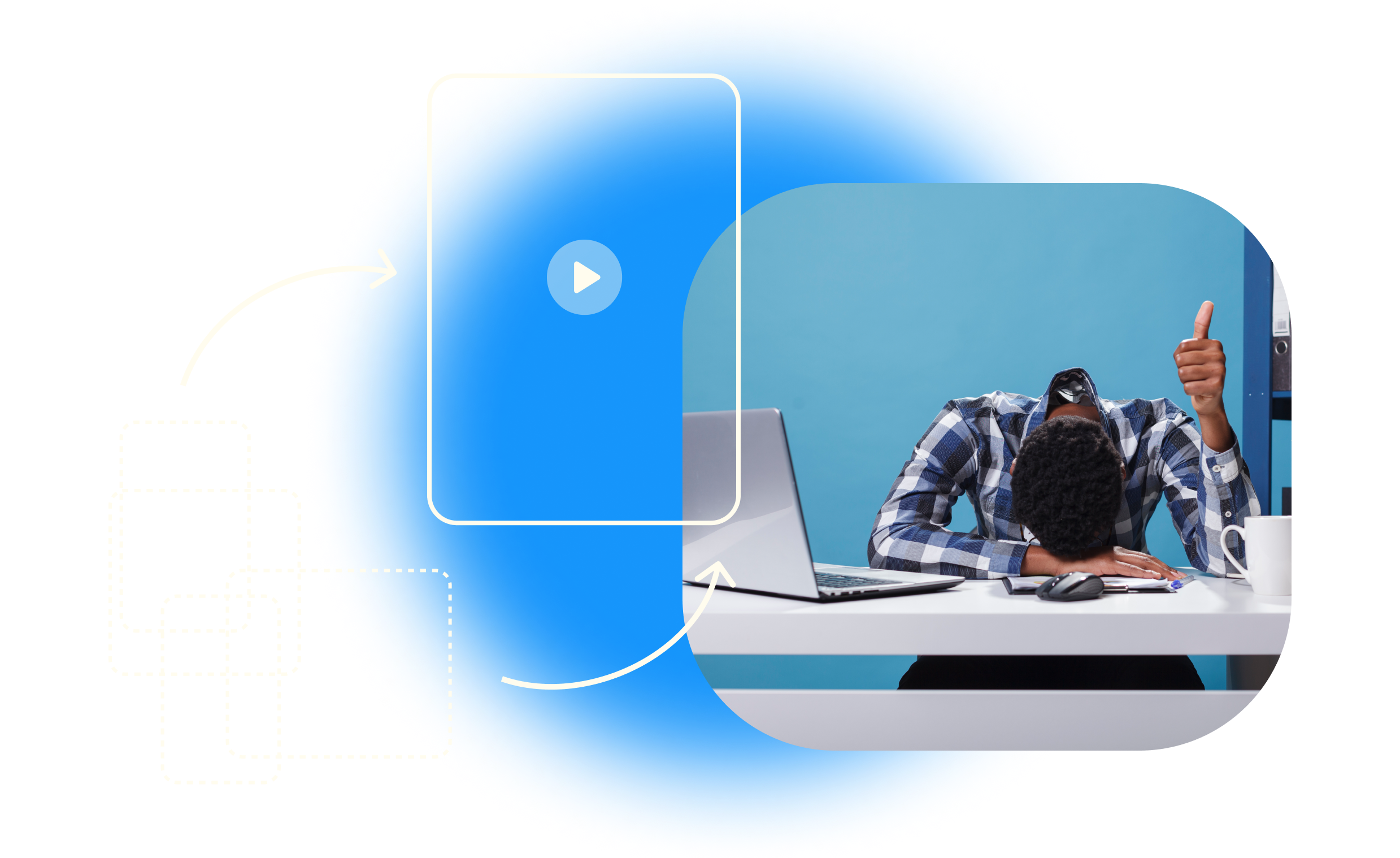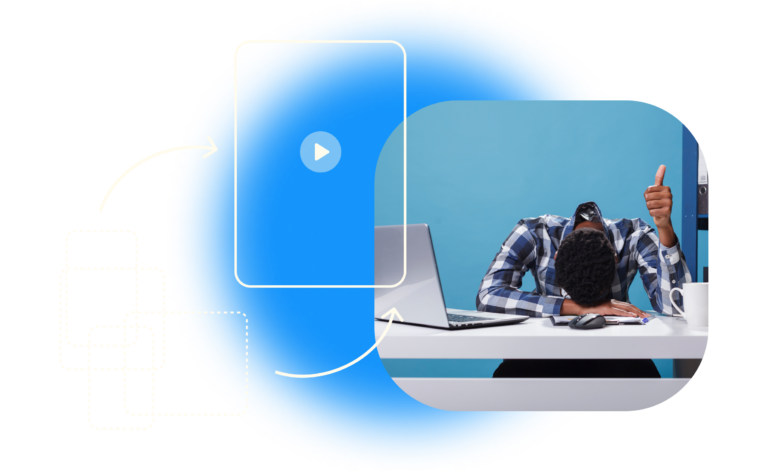SHARE
Extract
Video editors can avoid burnout by balancing work-life, utilizing AI tools like Adobe Sensei and Descript for repetitive tasks, and establishing creative routines such as regular breaks and exercise. Collaboration, professional development, and efficient project management are also key strategies.
Video editing is an exciting and creative profession, but it can also be very demanding and exhausting. Burnout is a real problem that affects many professionals in this field, leading to a decline in creativity and mental health. Below, we explore how video editors can find a work-life balance, use automation tools, and establish creative routines to maintain inspiration and avoid burnout.
1. Finding a Work-Life Balance
Work-life balance is crucial to maintaining creativity and mental health. Burnout occurs when video editors work excessive hours without taking time to relax and recharge. According to Peech, 66% of marketers don’t create videos because they believe it is too laborious and time-consuming (Peech). Here are some strategies to achieve a better balance:
- Set Clear Limits: Define specific work schedules and stick to them. Avoid working outside these schedules to ensure sufficient time for rest and personal activities.
- Plan and Prioritize: Use time management tools such as Trello or Asana to plan your day and prioritize tasks. This will help you stay focused and reduce your workload.
- Digital Disconnect: Take time to completely disconnect from screens and social media. Practice hobbies that don’t involve technology to give your mind a break.
- Time for Family and Friends: Make sure to spend quality time with your loved ones. This emotional support can be crucial to maintaining a healthy and balanced outlook.
2. Automation and Use of AI
Automation and the use of artificial intelligence (AI) can be powerful allies for video editors, helping them reduce workload and focus on the more creative aspects of their projects. According to Teal Careers, the integration of AI into the video editing process is on the rise and can significantly improve efficiency and creativity (Teal Careers). Here’s how to take advantage of these technologies:
- Repetitive Task Automation: Use AI tools to automate repetitive tasks such as clip sorting, basic color correction and audio transcription. This not only saves time, but also reduces mental exhaustion. Examples of these tools include:
- Adobe Sensei: Integrated into Adobe Premiere Pro and After Effects, Adobe Sensei uses AI to enhance color correction, automatic editing, and facial recognition.
- Descript: This tool allows you to automatically transcribe audio and edit video as if it were a text document.
- AI-enabled Editing Software: Platforms such as Adobe Premiere Pro and DaVinci Resolve are incorporating AI features that help editors make automatic adjustments and intelligent suggestions to improve video quality.
- DaVinci Resolve: Offers advanced color correction and editing tools with AI features that make it easy to identify faces and apply automatic corrections.
- Magisto: An AI powered tool that makes it easy to create professional videos by automatically selecting the best moments from your footage and adding music and effects.
- Workflow Optimization: Implement project management software that uses AI to optimize workflow, from planning to final project delivery.
- Frame.io: This platform enables collaboration in the cloud, facilitating efficient video review and approval.
Explore more about the use of AI in video editing on our blog.
3. Establish Creative Routines
Maintaining creativity can be a challenge when working under constant pressure. Establishing creative routines can help you stay inspired and prevent burnout. According to Snov.io, consistency in creative habits is essential for developing and maintaining creativity (Snov.io). Here are some ideas to keep your creativity high:
- Take Regular Breaks: Incorporate frequent breaks into your daily routine. These breaks may be short but they are essential to clear your mind and maintain productivity.
- Exercise: Regular physical activity is not only good for physical health, but can also improve creativity and concentration.
- Seek Inspiration Outside of Work: Spend time in activities that inspire you, such as reading, watching movies, visiting museums or spending time in nature. These activities can provide new perspectives and stimulate your creativity.
- Practice Meditation and Mindfulness: Techniques such as meditation and mindfulness can help reduce stress and improve concentration, which is crucial for maintaining creativity at work.
- Set Daily Creative Goals: Set small daily creative goals to keep you motivated and focused. These goals can be as simple as experimenting with a new editing technique or working on a personal project.
For more tips on setting creative routines, visit Snov.io.
4. Collaboration and Constructive Feedback
Collaboration and feedback are essential components for growth and innovation in video editing. Working with other creatives and receiving constructive feedback can help you improve your skills and avoid burnout.
- Teamwork: Collaborate with directors, producers and other editors to gain different perspectives and improve the quality of your work. Diversity of ideas can inspire creative solutions.
- Constructive Feedback: Seek and accept constructive feedback from colleagues and clients. Honest feedback can help you identify areas for improvement and grow professionally.
- Effective Communication: Maintain open and clear communication with your team. This helps avoid misunderstandings and ensures that everyone is aligned with the project vision.
5. Professional Development and Continuing Education
Continuous learning is crucial to stay relevant and avoid burnout in the video editing industry. Participating in courses and workshops can help you acquire new skills and stay motivated.
- Online Courses: Platforms like Coursera and Udemy offer courses in video editing and emerging technologies that can help you improve your skills and learn new techniques (Coursera).
- Conferences and Seminars: Attend industry conferences and seminars to stay on top of the latest trends and technologies. These events are also excellent networking opportunities.
- Professional Certifications: Obtain certifications in video editing software and other relevant areas to demonstrate your expertise and enhance your career opportunities.
6. Project Management and Organization
Efficient project management and good organization are key to managing workload and avoiding burnout. Here are some strategies to improve your project management:
- Project Management Tools: Use tools like Trello, Asana or Monday.com to organize your tasks and projects. These tools can help you keep track of deadlines and make sure everything is on track.
- Prioritize Tasks: Learn to prioritize your tasks according to their importance and urgency. This will help you focus on what really matters and avoid work overload.
- Delegate Responsibilities: Don’t be afraid to delegate tasks to other team members when necessary. Delegating can ease the workload and allow you to focus on more important tasks.
Conclusion
Staying creative and avoiding burnout in video editing requires a balanced approach that includes effective time management, the use of advanced AI tools, and the creation of routines that foster creativity. By implementing these strategies, video editors can not only improve their quality of life, but also produce more innovative, high-quality work.
For more information and resources on how to improve your career as a video editor, visit Storimake.








